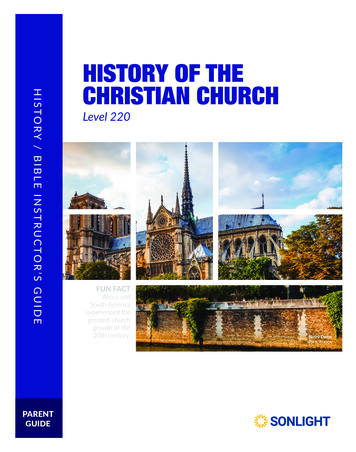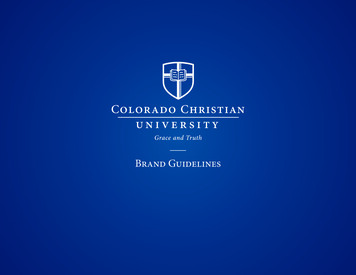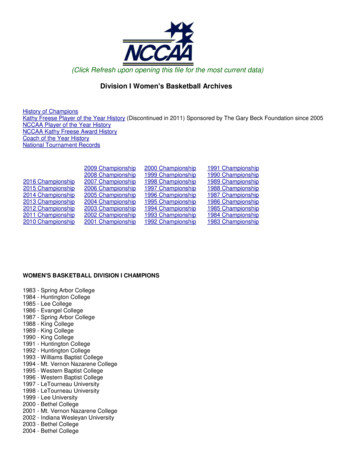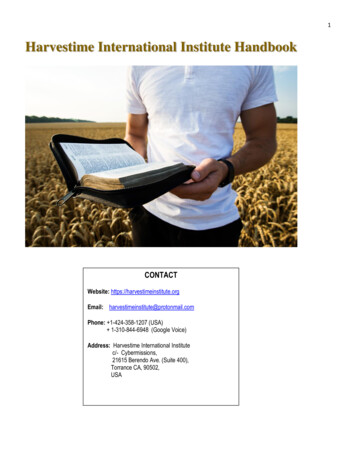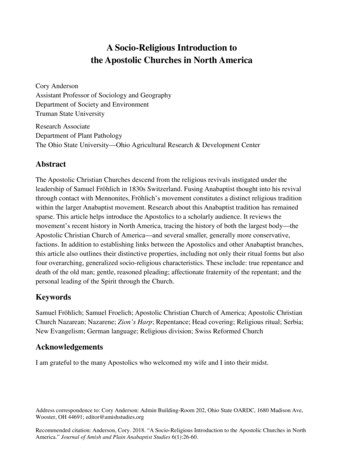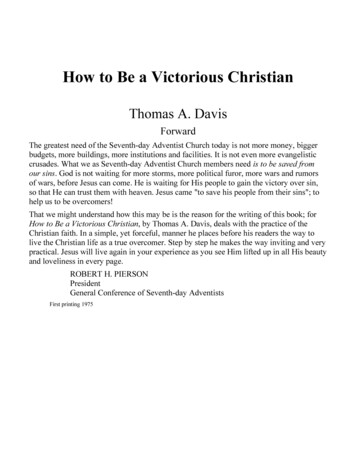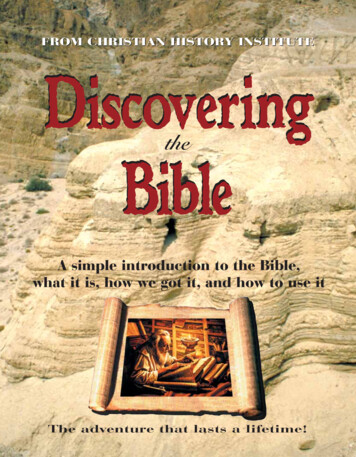
Transcription
FROM CHRISTIAN HISTORY INSTITUTEDiscoveringBibletheA simple introduction to the Bible,what it is, how we got it, and how to use itThe adventure that lasts a lifetime!
Welcome to the Adventure!Your discovery of the Bible could be an adventure that lasts your whole lifetime! Sound ridiculous? Maybe, butthere is an incredibly long line of people stretching for thousands of years who would insist it is true. Stop andthink. Long, long before the world knew anything of television, radio, CDs, airplanes, automobiles, electricity, longbefore the world ever heard of Coca Cola, IBM, SONY, or microwave ovens, a book that later became known as“The Bible”was written that would be like none other. This book was even finished centuries before printing wasavailable to mass produce books, and in those earlier centuries every copy of this book had to be done by hand.In every generation since it was written, it has been revered and looked to as a source of understanding ourworld, our humanity, our relationships, our reason for existence. Accept the possibility that the best things in ourWestern world, a world that slowly and painfully emerged from barbarism to an advanced civilization, emergedlargely from the inspiration provided by the Bible. It played a central role in the formation of our culture. Butnow the flowers of that civilization, as someone put it, are cut off from the roots and are already beginning towilt in the vase. Look at the solutions and cures that are typically offered. Do they give you much hope? Might itbe that the way forward is to go back to the path we drifted from, to recover our roots, to rediscover the Bible?What Kind of Book is This Anyway?The Golden Gate in JerusalemThe Bible deals with life and history with real people and specificplaces. This was the most important gate to Jerusalem in Jesus’ timeas the entrance to the holy place of the temple. Christians proclaimedJesus would return and enter Jerusalem through this gate. So, Moslemleader Saladin had it sealed in 1187. As you can see, it is still sealed.The Bible is often thought of as a “Holy Book.” Various religions have their “Holy Books.” Often these are reported as“revelations”coming through various means such asvisions, dreams, hearing directly from God, or an angel. Butthe origin of the Bible is accounted for in a quite differentway. The Bible is rooted and grounded in history. TheBible came from the experience of specific people, inidentifiable places, at particular times. The Bible deals withthe meaning of human life on this planet from within thestories of people who lived on this planet. So it is not a“Holy Book”in the sense of an otherworldly esoteric philosophy. It is “holy”in the sense that it represents theinteraction of God and people in our world in the midstof everyday life.First—take the quizBefore reading further, for a little fun and to check what awareness you might already haveof the Bible, go now to page 31 and take the little quiz there. Then come back.2
What to Look ForContentsPart I:General Overviewpage 5What is this book that is like none other? It has shaped our civilization and our language. It has generated heated controversy. It speaksto the small child yet challenges the greatest intellects. It comes froma small part of the world and introduces a new view of history.Part II:The Old Testamentpage 11The Hebrew scriptures were far more than ancient writings. Theyare still revered today as a love letter from God.What are theyabout? How were they collected? How were they so amazingly andaccurately preserved?Part III:The New Testamentpage 16It centers on one like none other in all of human history. It buildsdirectly on the Hebrew scriptures.What is it about? Can we possiblystill have the actual words of Jesus? How was the New Testamentgathered and confirmed?Part IV:Preservation, Circulation andInfluencepage 23It survived violent attempts to destroy. It took many forms and wasexpressed through various art forms. It was preserved over centuries. It is the most translated and circulated book ever, and overthe ages it has produced amazing results.Based on the four-part video curriculum series, Discovering the Bible.
What the Bible Deals WithThe basic questions we all face, such as What to think of ourselvesHow to deal with guilt and fearHow we are to relate to natureHow we are to treat each otherHow God reaches down to usHow we can find God4
Part I: General OverviewA Book Like None OtherwsThe Neaniine, utavconcubimoniaiperet parsuli decUmbracex agricolaa Perspicaine novs concubSaetosuEALL-TIMER:LLESTSBELETHE BIBThe world’s all-time best sellerOne of the writers of the Bible said, “Of making many books there is no end”(Ecclesiastes 12:12). An infinitesimally small number of books published rise upabove their day and age and are considered worth preserving. Some become recognized as classics. But even among the classics the Bible stands out as incomparable.The Bible is the most circulated book in the history of the world. It’s been this waysince the innovation of the Gutenberg press in the 1450’s when the Bible in Latinwas the first large book to be printed by moveable type. Ever since, year after year,more copies of the Bible are printed and circulated than any other book. For the mostrecent year over 60 million complete Bibles, over 90 million New Testaments, and over11 2 billion scripture sections were published in over 2,000 languages. The press runs keep growing every year.It shaped our worldand languageThe Bible has had a singular role in shaping our Westernworld. Our language is laden with Biblical imagery that havebecome embedded in our cultural consciousness. For example, The blind leading the blind, Turn the othercheek, Love your enemies, A “Good Samaritan,” Gothe extra mile, Separate the sheep from the goats, Ourdaily bread, For everything a time and season, Theapple of my eye.Gutenberg PressThe world’s most translated bookThe Bible has been translated into more languages than any other work everwritten. There are now translations in more than 2,000 languages. Today literally thousands of dedicated men and women linguists pour out their livesto provide the Bible into every active language group on the face of theearth. Often they provide the first written version of oral languages.Paez Indians in Colombia examine aBible translated in their own language.5
And a Most Controversial BookThough the Bible may exceed all the rest in circulation, it also leads in the controversy that it generates. The Biblehas always provoked heated debate, drawing passionate reactions from some of the most notable thinkers andleaders across the ages. The Bible will continue to have a major place in our society and the controversy is sureto continue.ASome love itBA Theodore Roosevelt (1858-1919)A thorough knowledge of the Bible is worth more than a college education.B Horace Greeley (1811-1872)It is impossible to mentally or socially enslave a Bible-readingpeople.CDC Abraham Lincoln (1809-1865)All the good from the Savior of the world is communicatedthrough this book All things desirable to men are containedin the Bible.D Emmanuel Kant (1724-1804)The Bible is the greatest benefit which the human race hasever experienced.Some hate itEE Voltaire (1694-1778)If we would destroy the Christian religion, we must first of alldestroy man’s belief in the Bible.FF Robert Ingersoll (1833-1899)The inspiration of the Bible depends upon the ignorance of thegentleman who reads it.GG Friedrich Nietzsche (1844-1900)One does well to put on gloves when reading the NewTestament everything in it is cowardice and self-deception.H Thomas Paine (1737-1809). . .It would be more consistent that we call it the work of ademon than the word of God. It is a history of wickedness thathas served to corrupt and brutalize mankind.6H
A Book for the Greatest Intellects and yet even for the small childMore books have been written about the Bible than any other subject, and the single person about whom more books have been written than anyone else comes from the Bible.It is Jesus. Over the centuries brilliant scholars have spent entire lifetimes trying to analyze and understand even small portions of the Bible.Yet the key sections of the Bibleeven small children in Sunday Schools are able to grasp.I heard one time the Bible being compared to a pool of water. A pool that in someparts is so shallow that a child can go wading, but a pool also that is so deep inother places that an elephant can go swimming there. Well, the Bible is a wonderful book that contains passages which in some cases are very deep and profound.Yet, in general the Bible as a whole is simple enough for anyone who is untutoredto read it and understand what God’s will and way would be for that person.Noted New Testament scholar, Dr. Bruce MetzgerDr. MetzgerStop and think of thisWhy is it that the Bible has been used, and only the Bible, for the swearing in of Presidents going all the way back to George Washington? Whyis it the Bible that witnesses place their hand upon in promising to tellthe “truth, the whole truth, and nothing but the truth, so help me God”before giving testimony in court?Washington takes oath of office.What does “Bible”mean?The word probably comes from the port of Byblos in Lebanon. Byblos was known to be an important placefor the shipment of papyrus.“Byblos” in the old Greek language originally meant the inner bark of thepapyrus plant. Papyrus was used for paper in the ancient world. We get the word paper from papyrus. It’sas simple as that. “Bible” simply refers to “book,” and what we think of as the Bible wasn’t even called theBible until about the 4th century AD.7
The World of the BibleEUROPEASIAMediterranean SeaIsrael JerusalemIn this shot fromNASA taken over theNile River, you seethe MediterraneanSea in the center, theNile Delta in thelower center, thestrait internationalboundary betweenIsrael and Egypt,where the coastlineangles, and AsiaMinor. This is theworld where mostBiblical events tookplace and where theIsraelite nation andthe Christian churchwere born and grew.AFRICAThe Bible, for the most part, centers on a small part of the world—seen here from space—with the primary eventstaking place in the small land of Israel. Israel is roughly the same in size as the state of New Jersey. You can readilysee why this region has always been a kind of crossroads of the world. Here Africa, Asia, and Europe meet. This iswhere most of the Bible was written and where most of the Biblical events happened. The focal point of the landsof the Bible, the small city of Jerusalem, is sacred today to Jews, Christians, and Moslems. This city is mentioned656 times in the Bible. Over the centuries it has been destroyed 17 times, and 18 times has been rebuilt.A Treadmill or a Track?The Bible’s view of what history is differs markedly from the typical viewsthat prevailed. In Bible times it wascommon to think of the world as anendless cycle, tied to nature and the seasons, or a “wheel of unending recurrences,” as the Greeks put it. Whereasthe Bible’s view is progressive or linear,with history having a purpose, and theworld moving forward to a goal.8
It’s Not Really a Book, But a LittleLibrary of Many BooksThere are two major oshuaJudgesRuth1, 2 Samuel1, 2 Kings1, 2 siastesSong of ggaiZechariahMalachiTHE OLD TESTAMENTThe Old Testament consists of 39 Books. The Hebrew Bible has 24 books, but those 24 books correspond exactlyto the 39 books in Christian Bibles. The difference is that the Hebrew Bible combines 1 & 2 Samuel, 1 & 2 Kings,1 & 2 Chronicles and Ezra & Nehemiah into single books, and counts the last 12 or “Minor Prophets”as one. TheOld Testament was written over a very long time. It took at least a thousand years, from 1400-400 BC, and nodoubt considerably more.1500 BC1250 BC1000 BC750 BC500 BC250 BCBC/ADMatthewMarkLukeJohnActs of the ApostlesRomans1, 2 1,2 Thessalonians1, 2 TimothyTitusPhilemonHebrewsJames1, 2 Peter1, 2 and 3 JohnJudeRevelationTHE NEW TESTAMENTThere are 27 New Testament books. The New Testament was written over a much shorter time than it took towrite the Old Testament. The New was written over a period of about 50 years from probably about 45 to 95 AD.BC/AD50 AD100 AD150 ADA word about terminology—“Old”and “New”can be misleadingIn our novelty crazed culture we often think of what is “old” as obsolete. It would have perhaps been clearer if the parts of the Bible were called the “first” and “second” testaments, or “earlier” and “later.” It is becoming more common today to refer to the “Hebrew Scriptures” and the “Christian Scriptures” instead of callingthem the “Old” and “New” Testaments.9
Some Bibles Have More Books—The Apocrypha or DeuterocanonicalsTobitJudithEsther (or the rest of)WisdomSirach (Ecclesiasticus)BaruchSong of the Three Holy ChildrenHistory of SusannaBel and the Dragon1, 2 EsdrasLetter of Jeremiah (Baruch chap.6)Prayer of ManassehPsalm 1511-4 MaccabeesThere is an additional section in Roman Catholic and Orthodox Bibles usually calledthe Apocrypha, or Deuterocanonical books (meaning a second canon). SomeProtestant Bibles also include them as valuable for edification but not as authoritativeScripture. These books were written between 300 BC and 50 AD and provide mostvaluable information and insight on the life and trials of the Jewish people betweenthe testaments. The events covered in the Old Testament ended at about 400BC. The New Testament writings began in the 40’s AD. Thus, the Apocryphaprovides an important bridge between the two testaments.500 BC400 BC300 BC200 BC100 BC BC/AD100 ADHere are two sample selectionsfrom the Apocryphal Books.Some practical wisdom from SirachBetter off poor, healthy and fit than rich and afflicted in body. Health and fitness are better than any goldand a robust body than countless riches. There is no wealth better than health in body, and no gladnessabove joy of heart. Do not give yourself over to sorrow and do not distress yourself deliberately. A joyfulheart is life itself, and rejoicing lengthens one’s life span. Jealousy and anger shorten life and anxiety bringson premature old age. Those who are cheerful and merry at table will benefit from their food. How amplea little is for the well-disciplined person. Healthy sleep depends on moderate eating. From Sirach, Chapter 30A savage ruler who tried to destroy the Jewish people and their bookAntiochus EpiphanesSyrian King Antiochus IV Epiphanes, nicknamed “the madman,” tried to imposeHellenism on the Jewish people. He desecrated their temple and carried on a merciless persecution.The Jews revolted and the Maccabean Wars resulted.Then the king wrote to his whole kingdom that all should be one people andthat all should give up their particular customs. He directed them to follow customsstrange to the land. They were to make themselves abominable by everythingunclean and profane, so that they would forget the law. The books of the law thatthey found they tore to pieces and burned with fire. Anyone found possessing thebook of the covenant, or anyone who adhered to the law was condemned to deathby the decree of the king. But many in Israel stood firm and were resolved in theirhearts not to eat unclean food. They chose to die rather than to be defiled by food orto profane the holy covenant; and they did die. 1 Maccabees chapter 110
Part II: The Old TestamentThe Old Testament is revered by JewsThe Hebrew scriptures decisively shaped the livingmemory and identity of a unique people. They arerevered as writings from antiquity, yet treasured eventoday as an ever living and unceasingly relevant word.To grasp what the Hebrew Scriptures are about,think of them as revolving around some key concepts, which for simplicity we will summarize withwords beginning with the letter “P.” They have to dowith:Providence—The Hebrew Scriptures manifest aconstant awareness that the God who created all isinvolved with His creation and active in human history.People—The people who descended from the greatpatriarchs—Abraham, Isaac, and Jacob—are chosenand set apart by God for unique service in, to, and forthe world.Place—The land of Israel promised to this people byGod if they would faithfully follow Him.Promise—This people and God were united by acovenant,or agreement,that God would be with them,guide them,bless them,if they would follow His ways.Prophecy—Warnings against injustice, idolatry, andsocial evil, and prophecy predicting future events,including the coming of a Messiah to save and deliver.A love letter from GodI read the Torah as Jews have read it and loved it forcenturies. For example, I can tell you what is the middle word in the Torah. I can tell you what is the middle letter in the Torah.Over the generations Jewishscholars have read the Torah not as a novel to seehow it ends, but as a love letter. For instance,‘Why didhe use this word instead of that word?’ ‘Why is there aspace here?’ ‘Why a comma here instead of a period?’That’s the way youread a love letter andwonder,‘What did he orshe mean by thisword?’ We Jews haveseen the Torah as notjust a book of stories orlaw codes, but as a loveletter from God.Comment by RabbiHarold Kushneron VISN TVArtist’s conception of Moses writing Torah.At the end of his life,Mosesadmonished his people:Take to heart all the words I have solemnlydeclared to you this day, so that you may commandyour children to obey carefully all the words of thislaw. They are not just idle words for you. Theyare your life.Deuteronomy 32:46- 47A man in present-dayJerusalem with an ancientscroll11
The Old Testament STORYJoshuaJudgesRuth1 and 2 Samuel1 and 2 Kings1 and 2 sEcclesiastesSong of nielMINOR (OR mHabakkukZephaniahHaggaiZechariahMalachiThe first five books are known as the Law or Torah or Pentateuch. The first,Genesis, contains the account of Adam and Eve, Noah and the Flood, and the callingof Abraham to found a great people. Abraham’s descendants go to Egypt to escapefamine. They are later enslaved, and Exodus through Deuteronomy tells the story oftheir deliverance under Moses and the wandering in the wilderness in preparationto enter the promised land. Included are the giving of the Ten Commandments andthe various ritual and communal laws given to guide Israel.After the death of Moses the Jews were lead by Joshua, and then by various judges,as related in the books of those names. The people wanted a king, and the otherhistorical books give accounts of the kingdom in Israel through Saul, David,Solomon, then the division of the land into two kingdoms. The story continues withthe capture of the two kingdoms, the North by Assyria in 721 BC, the South byBabylon in 586 BC. Ezra and Nehemiah tell of the return after captivity to rebuildthe temple and wall around Jerusalem.The wisdom books supply us with the instructive story of Job, an exploration onthe meaning of human suffering, the beauty and inspiration of a prayer and hymnbook—the Psalms, and the down to earth practical wisdom of Proverbs. Then thereis the earthly wisdom and analysis of Ecclesiastes and the rapturous love epic inSong of Solomon.The prophets speak to the nation and interpret God’s dealings with His people.They warn against idolatry, declare judgment on the people when they depart fromGod’s ways, but they also show the love and compassion of God to forgive, call Hispeople back, establish a new covenant, send a promised Messiah and ultimately fulfillthe Divine purposes for the world.The minor prophets are called minor not because they are unimportant butbecause they are briefer books. They are also known as “The Twelve.” Thesevarious writers continue the tradition of judgment and comfort. They containsome of the most piercing social criticism ever written.The Jews are continually warned of the punishments for infidelity to God’s ways, and the faithfulnessof God to restore his people in spite of their sins.Within the prophetic booksthere are many accounts of the steep price these spokesmen paid for their boldand courageous pronouncements. As you might guess, their message was oftenrejected and the prophets themselves attacked.12
Gathering the CollectionThe Old Testament collection was written over many centuries as we have noted. Scholars observe that there were oraltraditions as well as written accounts. Stories were told overand over, detail by detail, when the covenant people gatheredaround their campfires. And the stories were preserved onparchment, or animal skins, so the account of God’s dealingwith his people would never be forgotten. The parchmentswere rolled up into scrolls. Over the centuries more scrollswere written and added to the collection. Some were recognized as having special importance and came to beregarded as sacred text or holy scripture.Of course, none of the original scroll writings has been preserved. Scrolls would wear out and were given anhonored burial. But before they wore out, copies would be made and then copies of copies.Inasmuch as the books were written over at least a thousand-year period, there was an ongoing process to gatherthe collection. The early books of the law were stored in the ark of the tabernacle (Deuteronomy 31:26). Thenation reconsecrated its devotion to the sacred writings at different times (II Kings 23:1-3, Nehemiah 8:1ff).By the time of Jesus it seems that there was general agreement on what constituted the recognized collection ofsacred scrolls for the Jewish people. They are summed up in Jesus’ reference to the three main sections of theHebrew scriptures when He noted that “Everything must be fulfilled that is written about me in the Law ofMoses, the Prophets and the Psalms.” Luke 24:44A major tragedy in the life of the Jewish nation occurred in 70 AD when the Jewish temple, the center of Jewishreligious life, was destroyed by the Romans under Titus Livy. It is commonly thought that at a gathering of rabbisin the city of Jamnia in 90 AD there was a re-affirmation and confirmation of what fully and finally constituted the Hebrew scriptures.The Jewish historian Josephus, writing in the early 90’s AD in hisAgainst Apion, observed: For we have not countless books amongus, disagreeing and contradicting one another but only twenty-twobooks, which contain the records of all the past times; which arejustly believed to be divine and how firmly we have given creditto these books of our nation is evident by what we do; for duringso many ages as have already passed, no one hath been so bold aseither to add anything to them, to take anything from them, or tomake any change in them, but it has become natural to all Jews,immediately and from their very birth, to esteem these books tocontain divine doctrines, and to persist in them, and if occasion be,willingly to die for them.Artist’s depiction of destruction of templein Jerusalem in 70 AD13
An Amazingly Reliable PreservationAre the copies of the Old Testament writings we have today anything like what was originally written down solong ago? Quite amazingly, the answer is yes. For the most part we can be confident that what we have today isnearly identical to the ancient copies. We back that up by drawing your attention to the scribes and the scrolls.The ScribesThe copies of the scrolls of Hebrew scripture were made by a special group known as scribes. Israelite scribeslearned their craft as a kind of holy profession in family-like guilds as is attested in the Bible that mentions “Clansof Scribes who inhabit Jabez” I Chronicles 2:55.The Hebrew word for scribe is sofer. Its root meaning is “to count.” And scribes indeed were careful countersmaking sure every word and letter were accounted for. They worked under very strict conditions and regulations. They went about their work with a seriousness many would consider almost fanatical today.For example, the Jewish Masoretic scribes, who made hand written copies of the Bible worked under rulesdesigned to insure utmost accuracy. No word or letter could be written from memory (the scribe had to say the word aloud). Before writing the sacred name of God, the scribe had to pause and wipe his pen. A scroll was discarded if spelling errors were found. Perhaps most important—after copying, every single word and every letter was counted to verify accuracyand to be sure they matched the original. Before beginning his work, a scribe would cleanse himself in a ritual bath—a vivid evidence of theseriousness and sacredness of the task of writing a scroll. He was going to write the names of God andmust do so with proper devotion and ritual purity.Steps in the remains of an ancient Jewish bath used for ritual purificationArtist’s depiction of scribe copying manuscript14
The ScrollsThen there are the Dead Sea Scrolls. Maybe you have heardthe fascinating story of how a Bedouin shepherd boy in 1947was out with his flock along the cliffs on the northwest sideof the Dead Sea.He thoughtlessly threw a rock into one of the caves.He heard something break. He investigated and found ancientscrolls stored in large pottery jars.The lad had accidentally stumbled across the greatest manuscript discovery of modern times. Many of these scrolls dateback to before the time of Jesus, and they include copies ofsections of every Old Testament book except Esther. There isan almost complete copy of the book of Isaiah. Up until thediscovery of the scrolls, the oldest available copies of theQumran cave where the Dead Sea Scrolls were foundHebrew scriptures dated from around 900 AD. These DeadSea scrolls provided Hebrew text that was one thousand years earlier and would show if the text had been corrupted and changed over ten centuries. So it was a priceless opportunity to see if copies done so much later inany way resembled much earlier copies, that were themselves, of course, that much closer to the originals.So, just how well had the scribes done their job over so many generations? Scholars analyzed and discoveredthere were some differences. That is not the surprising part.What is surprising is that there were so few differences and they were primarily on small matters such as minorspelling variations. This is so amazing that it would almost seem impossible. The first ancient Qumran texts ledto just thirteen minor yet clarifying alterations in the modern Revised Standard version of the Bible.Section of scroll of Isaiah from the Dead Sea Scrolls15
Part III: The New TestamentThe Central Focus on Jesus the life, character, and teaching of Christ constitutethe most fascinating feature in the history of Westernman.Historian Will DurantObviously there would be no New Testament if itwere not for Jesus. Jesus left us no writings. His lifeand ministry, and what He said they meant, were preserved and passed on by His key followers. Theyspread this message far and wide in spite of horrendous persecution. And their teaching was not setforth as just one more religious option among thedozens circulating in the the multi-cultural Romanempire. The Gospel of Christ was boldly announcedas God’s ultimate word, God’s manifestation in humanflesh. Christ, they said, came to show us what Godwas like, how He would save us, and how we shouldlive. For many, then as well as now, the whole ideawas absurd. For some it sounds almost too good to betrue. For others it is too true to be good. For thosewho believed, in countless cases—the record is indisputable—this message completely changed their lives.So Jesus is set forth by the New Testament writers notas just a great religious leader. He is seen as the personal fulfillment of centuries of promise, prophecy,waiting, and hope that reverberate throughout theHebrew scriptures, a collection whose last book waswritten some 400 years before Jesus was even born.And the New Testament also clearly and repeatedlyspeaks of Jesus coming again a second time to establish a kingdom of justice, love, truth and righteousness.Jesus seen as fulfillmentof the promisesThere are at least fifty predictions in the Old Testamentabout a coming Messiah, or Savior-Deliverer, that the NewTestament writers saw fulfilled in Jesus. Here are just afew.Old TestamentPredictionNew TestamentFulfillmentMicah 5:2Isaiah 7:14Isaiah 35:5-6Zechariah 11:12Matthew 2:1Matthew 1:23Matthew 9:35Matthew 26:14-15Psalm 41:9Psalm 22:16Mark 14:17-21Luke 23:33The Jesus of the New Testament is seen offering an invitation to every human being on the face of the earth.The invitation is to repent of our sins,turn to God,accept Christ’s death on the cross in our place for oursins,turn to Him in love and faith,make Him central inour lives,and seek His strength to live our lives in a waythat will please God.SubjectBorn in BethlehemBorn of a virginCure deaf and blindSold for 30 pieces ofsilverBetrayed by a friendKilled amidst criminals16
Other Key Figures in the New TestamentIt will help you navigate through the New Testament if you are aware of:Peter and PaulPeter is a a prominent figure in the four Gospels, a major player in theexpansion of the early church as seen in the Book of Acts. He is alsocredited with writing two New Testament books and is most probablythe source for Mark’s gospel. Christians in every generation haveempathetically identified with Peter because of his impulsiveness,obvious flaws and outright failures. He could have easily been forgotten as just another loser. But he found forgiveness, renewed faith andbounced back to provide critical leadership for the early church.Artist’s depiction of Peter and PaulPaul was not one of
the origin of the Bible is accounted for in a quite different way. The Bible is rooted and grounded in history. The Bible came from the experience of specific people,in identifiable places,at particular times.The Bible deals with the meaning of human life on this planet from within the




